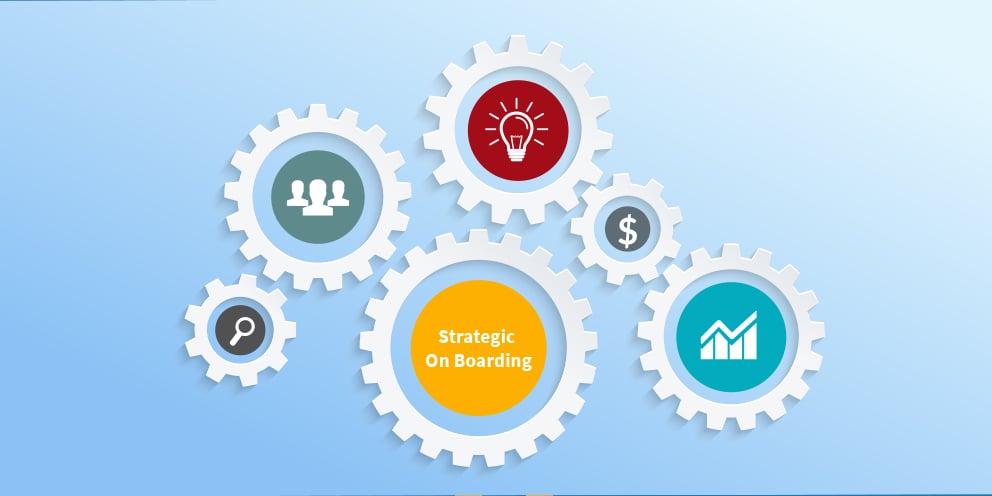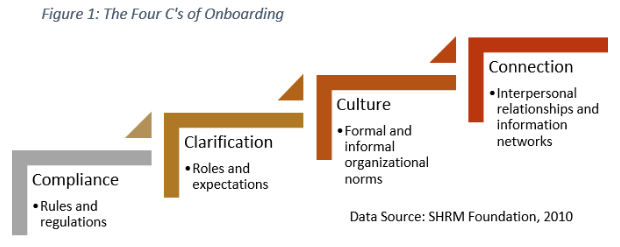 What is the icebreaker that initiates and accelerates the quality performance of today’s global enterprises?
What is the icebreaker that initiates and accelerates the quality performance of today’s global enterprises?
What is the key that unlocks the door of a productive workforce?
The key is Strategic on-boarding.
It is the buzzword in the current global corporate scenario, and it is the factor that controls the potentiality of future success. The more engaging and strategic it is, the more benefits it offers to an organization, adding to longevity. A perfect strategy creates an ambiance of determined employees that greatly influences the bottom line.
On-boarding, times ago, was just confined to a one day orientation of enterprise’s introduction, employees to do’s, benefits details and anything else that seemed essential to be communicated to the new hires, but now it underwent a sea change and rose up to be a key business accelerator, playing a major role in promoting sustainable organizational development.
The transition in this process is a total welcome as it constantly adapts itself to the existing attitude of the millennials(Generation Y) and now let’s consider into what form it has come into and how it exactly benefits the organizations. Strategic on-boarding today involves-
Business focused talent hiring
Gradually it began to initiate the process of talent hiring, it is never the traditional one but lays its focus on the business goals that are to be attained in the long run. The HR team being circumspect, plans the program with utmost thought to hire the right talent, fit to influence the business environment that the organization resides in. From the first minute, the new hires are attended to the maximum and are given complete heed. Thus it has become a talent hiring and nurturing function that steps towards yielding effective business outcome.
Communication and employee collaboration
It has also become a way in which new hires are encouraged to build networks with peers and superiors and other valuable resource providers. It is at this juncture that genial relations are formed among the employees and the new hires through which teamwork and collaborative functioning develop determining employee engagement, very crucial for successful organizational culture.
Engagement and interaction
Now it is an engaging and interactive process of relentless efforts that enables employers to keep up with the new hires, enabling them to comprehend their duties and providing them with immediate feedback, besides keeping them totally engaged and interactive with the flow of the enterprise’s culture. The new hires are no longer left desolated but their visibility and involvement is a matter of high priority, hence there’s a continuous escorting of the new hires from the initial point to the point where they become determined to contribute to the enterprise’s success.
Promote core values
The key of the on-boarding is the promotion of enterprise’s values, its vision and mission. It is the initiator of extending enterprise values to the new lot on the first day. It is a gradual happening through which the new hires learn about the enterprise’s culture and values, building a firm bond. This part greatly motivates and reaps in retention.
Learning and Retention
It implies the process of constant learning, it always aims to keep the new hires to learn and hone their skills to deliver quality results. It entirely focuses to sharpen the learning curve adding to bring out a productive workforce that pull back greater returns in a very short time. Another favor is, the total engagement of new hires with constant chiseling of the skills reduces sudden attrition and rises the scope of retention.
Innovation and Technology
In most of the successful enterprises, the process is being effectively integrated with innovative trends and technologies that act as catalysts in dealing with prolonged processes, enabling quicker ways of completion of multiple operations at a single stretch.
How it Benefits
This entire transition of on-boarding, by its nature of adapting to the current demands, accrues the fitting talent that completely outweighs the investments, operates with targeted strategies that draw in maximum business expansion and ultimately become the promoters of business sustenance.
 When software vendors first introduced onboarding in the cloud in the late 2000s, they were merely content and task management tools, but even that was a big step forward. For many of our colleagues, it helped shift the focus from administrative details to people.
When software vendors first introduced onboarding in the cloud in the late 2000s, they were merely content and task management tools, but even that was a big step forward. For many of our colleagues, it helped shift the focus from administrative details to people.
The marketing and consulting efforts in onboarding over the past decade have fueled a supercharged interest in onboarding practices that have little to do with software. In fact, you can have an effective onboarding program without automation—if you can manage the administration.
Components of Onboarding
One of our gray-haired colleagues described his assimilation into an HR organization in 2001. John’s story shows how an HR department in an organization of 9,000 employees expressed its commitment to newcomers. It shows us how an onboarding process focused on assimilation and development results in better performance. He suggested his experience as a model for effective onboarding.
- Introduce the team before the first day of work. The interview process included a tour of the work area and informal conversations with the people on the team. (John learned later that their approval was required.)
- Initiate a personal welcome. Immediately after he accepted the offer, the team manager called to welcome him. An HR representative called to tell him exactly what to expect, where to go, and what to do in the days leading up to his start date.
- Remove first-day jitters. The HR rep gave him complete information on how to dress, where to report, and what to bring with him. She told him lunch would be provided. She remained in contact and answered his questions quickly.
- Make the first day a social occasion. After a one-on-one signing session with an HR rep, John endured the standard “here’s what you need to know” presentations, most of which were interactive and informative. Lunch was a celebration with his new team and a few key people in the organization he needed to know. His workstation was ready for him, with all the tools he needed.
- Set clear expectations. The manager described the learning path and performance expectations, and set milestones for development. John’s team leader gave him his personal set of reference materials and resources on everything from statutes and regulations to job evaluations.
- Use frequent feedback to assimilate and develop. John’s team leader/coach led him through a year-long assimilation into the work structure, the organization, and the depths of the essential body of knowledge. She led him through a series of assignments of increasing responsibility. He participated in team decisions and led projects from the beginning of his tenure. He had frequent progress reviews, always with a focus on the future.
- Celebrate achievement. The end of the training period was another celebration and the gift of his own portfolio of organizational units to support.
/Data_Sheets%20Resource%20Home%20page%20images/D17_HCM_Payroll_resource.png?width=264&name=D17_HCM_Payroll_resource.png)
Why You Need Onboarding Automation
Our colleague’s experience can also help us understand why you need automation. While the intent and department culture supported assimilation, administration was difficult. Here are the most troublesome difficulties administrators faced.
- Non-compliance. Since new hire paperwork was decentralized, it was hard to track compliance of items like I-9s. Every incoming file had to be audited, and no one could be sure what was in records. When the only indicator a required form was completed is hidden away in musty employee archives, how could you know?
- In was Inefficient. The department was buried in checklists. Nobody trusted them.
- It wasn’t scalable. The practices he described were not organization-wide. The culture existed only in his department.No mechanisms existed to extend these practices to other parts of the organization, except those who were willingly influenced by example.
Even if your automated onboarding is only task management, it still has value. But if you want your organization to move beyond the basics to the kind of program that affects the top and bottom lines, you need more.
Next Generation Onboarding
In a 2010 SHRM report, Talya Bauer presented the four C’s framework for evaluating employee onboarding programs. She uses her model to assess an organization’s onboarding maturity, taking new hire development beyond administration and acculturation to the relationships connections that make people and teams effective.[1]

Bauer’s work is relevant today. The nature of work is changing. The top-down hierarchical business models do not move quickly enough to be competitive in today's’ business environment. Innovations in organizational design are re-creating flatter, more responsive organizations consisting of cross-functional teams of teams.
Connection Technology
Onboarding vendors now provide the communications your people need to develop into connected employees. Talent management suites include embedded links to the activities that support the onboarding plan, and solutions that are not mobile-enabled have become rare.
- Embedded connections to continuous performance feedback tools strengthen the relationship between employee and manager.
- Embedded learning and development delivers just-in-time learning at the point of need.
- Collaboration tools linked to onboarding facilitate team activities and team management. Many of these include team feedback mechanisms.
Consider Your Options
If your onboarding solution doesn’t have these communication tools, you may not need to throw it out. Investigate first whether you can use integration tools to coordinate them with onboarding. With the current standardized methods of connecting applications, you may find it is much easier than you think.
References:
1. Bauer, Talya N., PhD. "Onboarding New Employees: Maximizing Success." SHRM Foundation. 2010.
 The rise of onboarding technology and improved practices over the past two decades transformed the new employee experience. What was once days of paperwork, boring orientation lectures, and tedious training has disappeared in most companies. In high-performing organizations onboarding has become a holistic approach to assimilation into the workforce. It begins long before the first day of work and continues for the entire employee life cycle, with renewed emphasis whenever an employee promotes or transfers.
The rise of onboarding technology and improved practices over the past two decades transformed the new employee experience. What was once days of paperwork, boring orientation lectures, and tedious training has disappeared in most companies. In high-performing organizations onboarding has become a holistic approach to assimilation into the workforce. It begins long before the first day of work and continues for the entire employee life cycle, with renewed emphasis whenever an employee promotes or transfers.
Why Virtual Onboarding Benefits Your Business
Effective onboarding programs begin at the moment a candidate accepts an offer of employment. The time between the offer and the first day of work can be days or weeks. Lack of communication creates doubt about the decision, and candidates will walk away from offers if they feel a prospective employer is not interested in them. We have done it ourselves.
Workers in virtual offices, remote locations or global organizations may never have a face to face encounter with people in your central organization. Making them part of the culture requires stimulating online virtual experiences.Virtual onboarding improves consistency in geographically dispersed organizations while providing opportunities for localization of policies and procedures.
Onboarding done well improves time to full productivity or time-to-competence, but the transformation to full productivity requires more than job skills. It includes assimilation into the culture, performance expectations, and socialization. Virtual learning can help with all of these factors.
One of the primary benefits is reduced cost, not only because of the reduced cost of training delivery, but also lower new employee turnover.
Virtual learning gives you the ability to use several modes in a blended learning approach, which improves learning retention.
Recommendations
We can recommend the following practices to take advantage of virtual onboarding.
- Manage onboarding as a project. Use onboarding technology or a project plan to define the onboarding process from beginning to end, with specific milestones.
- Avoid “One Size Fits All” Onboarding. In a multi-generational, globalized environment, onboarding requires multi-modal learning and information delivery and localization. It should also be tailored to the job role.
- Complete as much of the paperwork as you can online and before the first day of work.
- Go mobile. Make sure all your resources are well-adapted to mobile use, especially for the generations that grew up with mobile devices.
- Use e-learning with gamification to enhance learning about company products and services, company history, the industry sector, culture, and benefits elections.
- Use collaboration tools. If you don’t have a company collaboration tool like Yammer, Trello, or Producteev you can create private groups on LinkedIn or other social media platforms.
- Get personal with videoconferencing. A welcome phone call or email from the hiring manager is a nice touch. You can reap additional benefits with a video call. Try including the new employee’s work team in a brief welcome call.
Virtual onboarding can help you improve time-to-productivity, increase employee engagement, lower new hire turnover, and save training costs. The result will be a more engaged workforce, higher productivity, and improved business results.
See our onboarding infographic to learn more about how onboarding can benefit your business.






/Data_Sheets%20Resource%20Home%20page%20images/D17_HCM_Payroll_resource.png?width=264&name=D17_HCM_Payroll_resource.png)

